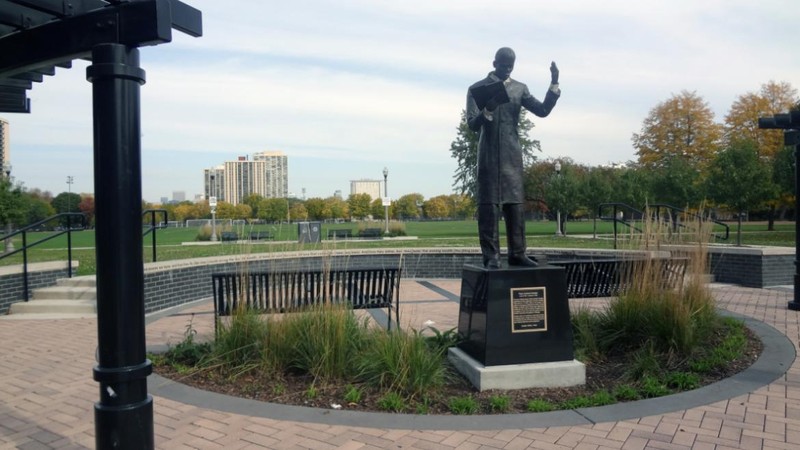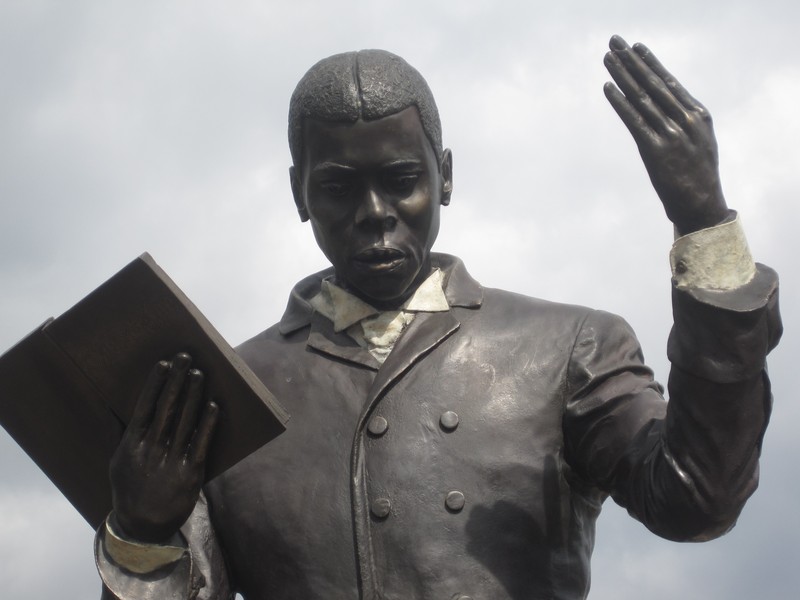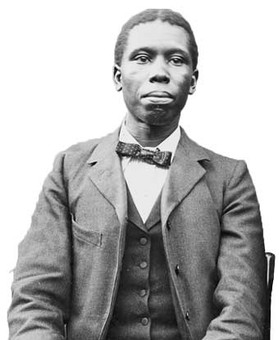Paul Laurence Dunbar Monument
Introduction
Text-to-speech Audio
Images
Paul Laurence Dunbar Monument in Chicago's Dunbar Park

A closer look at the bronze statue

A photograph of Dunbar taken around 1900

Backstory and Context
Text-to-speech Audio
Paul Laurence Dunbar was born in Dayton, Ohio on June 27, 1872. His parents, former slaves from Kentucky, separated a few years after his birth. While living with his mother in Dayton, he attended the city’s Central High School. Despite being the only African American in his class, Dunbar nevertheless found acceptance and participated in the school’s debate and literary societies, in addition to serving as the editor of the school newspaper. During his high school years, he also published poems in the Dayton Herald and edited the Dayton Tattler, a short-lived daily African American newspaper published by classmate Orville Wright.
Financially unable to attend college after graduating from high school in 1891, Dunbar found work as an elevator operator. The following year, one of his former teachers invited him to recite some of his poetry at a meeting of the Western Association of Writers in Dayton. At the gathering, Dunbar befriended James Norton Matthews, who later wrote a letter to an Illinois newspaper praising the work of the young African American poet. Soon after, newspapers across the country reprinted Matthews’s letter. The letter eventually caught the eye of poet James Whitcomb Riley, who read some of Dunbar’s work and then wrote a letter of encouragement to the young poet. Heartened by the support of Matthews and Riley, Dunbar self-published his first collection of poetry, Oak and Ivy (1893). To cover the costs of publication, Dunbar sold copies of the volume for $1 to the people who rode his elevator.
Later that same year, Dunbar moved to Chicago with the hope of finding work at the World’s Columbian Exposition. There, he met an elderly Frederick Douglass. The prominent abolitionist and civil rights activist not only found Dunbar a job as a clerk, but also arranged for him to recite some of his poetry at the fair. After the conclusion of the World’s Columbian Exposition, newspapers and magazines across the country, including the New York Times, published Dunbar’s work. In 1895, he published his second collection of verse, Majors and Minors, which earned a positive review from novelist and critic William Dean Howells in Harper’s Weekly. Howells’s praise garnered Dunbar national and international fame. In 1897, he completed a six-month tour of England, during which he recited his poetry to large gatherings.
After returning to the United States later that same year, Dunbar accepted a position as a clerk at the Library of Congress in Washington, D.C. and married writer Alice Ruth Moore. Both his tenure at the Library of Congress and his marriage to Moore did not last long. Blaming book dust for the onset of health problems, Dunbar left his position in 1898 to devote himself entirely to his writing. This led to a massive outpouring of work, including a collection of short stories, Folks from Dixie (1898), a novel, The Uncalled (1898), and two collections of poems, Lyrics of the Hearthside (1899) and Poems of Cabin and Field (1899). In 1902, Dunbar separated from his wife after only a few years of marriage. After which, he suffered a nervous breakdown and battled a case of pneumonia.
Despite poor health, which plagued him throughout the remainder of his life, Dunbar continued to write. He published two collections of poems in 1903, Lyrics of Love and Laughter and Lyrics of Sunshine and Shadow, and another, Howdy, Howdy, Howdy, two years later. Together, the volumes cemented Dunbar’s position as the leading African American poet in the country. As his health further deteriorated, he moved back to his mother’s residence in Dayton. There, he died on February 9, 1906 at the age of thirty-three.
More than a century after Dunbar’s death, as part of an effort to renovate the city’s Dunbar Park, the Chicago Park District and the Paul Laurence Dunbar Advisory Council proposed that a monument be erected in the park to honor the trailblazing African American poet. To this end, they invited local artists to submit design proposals, and in 2012 selected the entry submitted by sculptor Debra Hand. Unveiled two years later, the monument consists of a six-foot-tall bronze statue of Dunbar on a simple Black marble pedestal. The sculpture depicts him standing, reciting a poem. He holds an open copy of Oak and Ivy in his right hand, while his left makes a gesture. The monument stands in a plaza that includes a knee-wall into which are inscribed stanzas from Dunbar’s poems.
Cite This Entry
Curran, Francis. "Paul Laurence Dunbar Monument." Clio: Your Guide to History. March 5, 2021. Accessed March 23, 2025. https://theclio.com/tour/518/12
Sources
Cholke, Sam. "Statue of Poet Paul Laurence Dunbar is a First for Chicago Parks." DNAinfo, September 6, 2014 <https://www.dnainfo.com/chicago/20140906/douglas/statue-of-poet-paul-laurence-dunbar-is-first-for-chicago-parks/>.
"Paul Laurence Dunbar." Encyclopædia Britannica. 5 February 2021. Web. 5 March 2021 <https://www.britannica.com/biography/Paul-Laurence-Dunbar>.
"Paul Laurence Dunbar." Poetry Foundation. Web. 5 March 2021 <https://www.poetryfoundation.org/poets/paul-laurence-dunbar>.
"Paul Laurence Dunbar." Poets.org. Academy of American Poets. Web. 5 March 2021 <https://poets.org/poet/paul-laurence-dunbar>.
"Paul Laurence Dunbar Monument." Chicago Park District. City of Chicago. Web. 5 March 2021 <https://www.chicagoparkdistrict.com/parks-facilities/paul-laurence-dunbar-monument>.
https://www.chicagoparkdistrict.com/media/dunbar-park-paul-laurence-dunbar-monument
https://dixonl2014.wordpress.com/2014/10/11/new-paul-laurence-dunbar-statue/
https://www.nps.gov/people/paul-laurence-dunbar.htm

